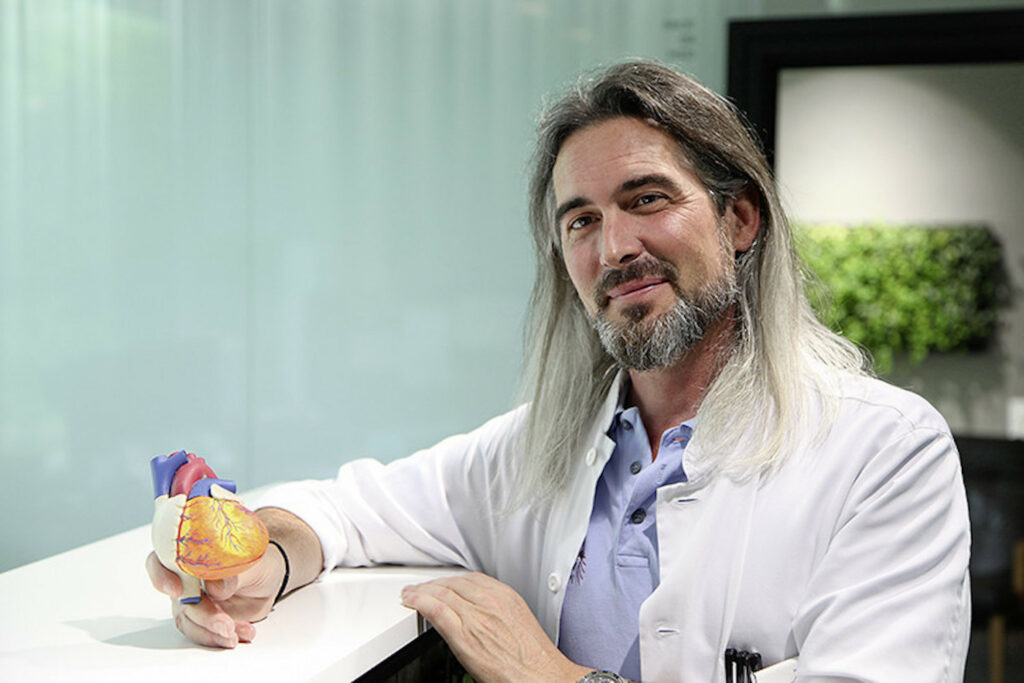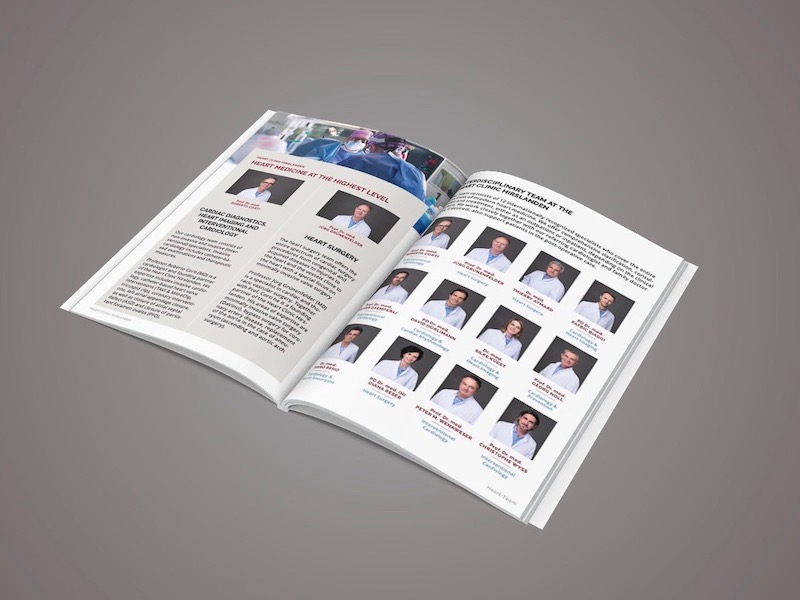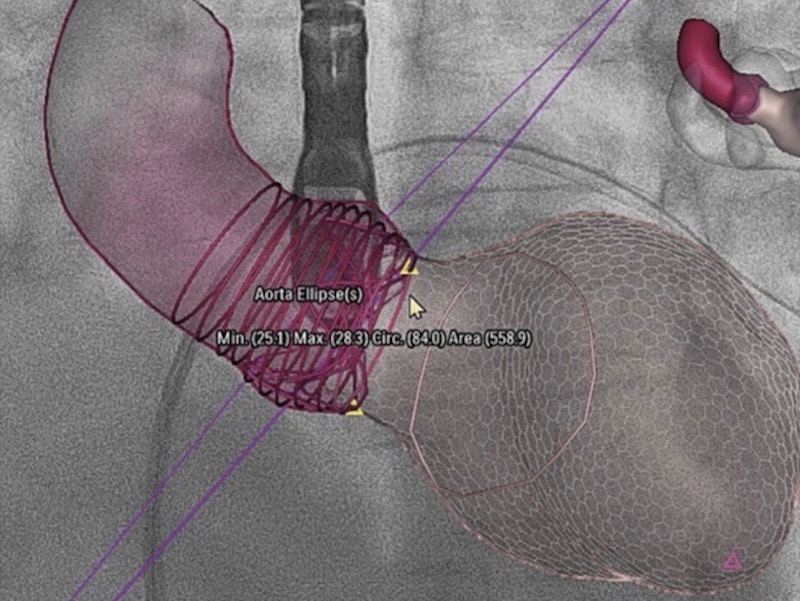Heart attack - Precious minutes
10 January 2020
Every minute is precious in the event of a heart attack
The earlier a heart attack is treated, the higher the chance of survival and the less permanent damage there is. This requires rapid action and smoothly functioning emergency care. However, a heart attack always requires a portion of luck, as the example of Marcel Waespi shows.
Patient report with interventional cardiologist PD Dr. med. Christophe Wyss
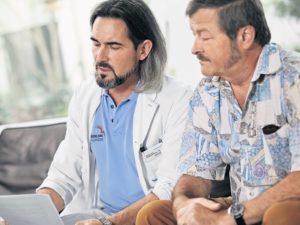
Interventional cardiologist PD Dr. med. Christophe Wyss talking to patient Marcel Waespi: He suffered a heart attack which was treated in time in the cardiac catheterisation laboratory. Image: Sara Keller Photography
Five years ago, there was little to suggest that Marcel Waespi would suffer a heart attack. The then 59-year-old was neither a smoker nor overweight and also played football regularly, even in a club in the past. Above all, however, he did not exhibit the typical symptoms of coronary heart disease, i.e. a circulatory disorder of the heart that precedes most heart attacks. These include feelings of tightness and chest pain that occur during exertion and are known as angina pectoris. Waespi's only known risk factors were his diabetes and high blood pressure, both of which were well controlled with medication. In addition, there was a high level of stress to which the executive was exposed for years, first at Swissair and then at SR Technics, despite great professional fulfilment. But there was little reason to suspect that this stress was doing his heart any good, given that he had no complaints.
Against this background, it is not surprising that Waespi did not immediately think of a heart attack when he was struck by diffuse upper abdominal pain and a peculiar malaise in the night from 1 to 2 May 2014. At 5.30 in the morning it was clear to him that he had to see a doctor immediately. And so, after a brief call to his family doctor, he and his wife drove to the emergency ward of the Hirslanden Clinic in Zurich, where he introduced himself with the sentence: "Full service, please!" After describing his symptoms, an ECG and a blood test, it was clear that Waespi had suffered a heart attack. He was immediately taken to the cardiac catheterisation laboratory, where he was treated by interventional cardiologist PD Dr Christophe Wyss.
Rapid reopening of the vessel
Coronary angiography, an X-ray examination of the coronary vessels using a catheter, showed one completely occluded and two severely narrowed coronary vessels. In order to reopen the blocked vessel as quickly as possible, Dr. Wyss pierced the clot with a wire inserted through the catheter tube and then dilated the vessel with a balloon. To prevent the vessel from closing again, Dr. Wyss could have inserted a stent, as is usually done after a heart attack. The other two narrowed coronary vessels could also have been treated with a balloon and a stent. However, as Marcel Waespi's cardiac output was already severely reduced due to the circulatory disorder, Dr. Wyss and the heart surgeon who had been called in recommended a different procedure, namely immediate bypass surgery. Marcel Waespi gave his consent and added: "I came in here alive and I want to leave here alive again." He was then taken directly from the cardiac catheterisation laboratory to the operating theatre.
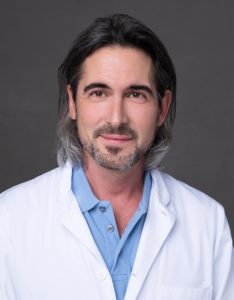
PD Christophe Wyss, MD - Interventional Cardiology - HerzKlinik Hirslanden
To bridge the narrowed coronary arteries, four bypasses were created from Waespi's own arteries and veins in a cardiac surgery operation lasting several hours. This restored the blood supply to the heart muscle. After the operation, Marcel Waespi was admitted to the intensive care unit for three nights for monitoring, after which he spent one and a half weeks in the nursing department. This was immediately followed by three weeks of rehabilitation at Lake Constance, where Marcel Waespi gradually regained his strength. After a further seven weeks he returned to work, initially at 50 per cent and just one month later at 100 per cent. Three years ago, Marcel Waespi took early retirement. Today he enjoys an active retirement, which includes excursions as well as regular sport. The fact that his wife cooks for him, not only well but also in a varied way, is an ideal complement to this. Only the daily intake of his heart and diabetes medication and the annual check-up with Dr. Wyss still remind him that his health also depends on the blessings of modern medicine.
Heart attack without warning
According to Dr. Wyss, who shares a cordial doctor-patient relationship with Marcel Waespi, his case is not atypical: "One in two heart attack patients does not know beforehand that he is suffering from coronary heart disease and is therefore at risk. However, even completely unexpected heart attacks seldom occur without prior warning. Often heart pain and shortness of breath occur in the hours or days before the attack and then subside. This was also the case with Marcel Waespi, who had to stop twice briefly a week before his heart attack due to such complaints, once while gardening and once while walking uphill.
Marcel Waespi was very lucky, as Dr. Wyss points out: "Half of the heart attacks that appear seemingly out of the blue end fatally. The cause is cardiac arrhythmia caused by the heart attack, which leads to sudden cardiac arrest. Because they can set in at any time after a heart attack and the time window for resuscitation in the event of sudden cardiac arrest is only ten minutes, Dr. Wyss advises patients to call the ambulance immediately if they suspect a heart attack. However, rapid reaction is also important for a second reason: once the heart muscle tissue has died, it does not regenerate but scars over. The result is cardiac insufficiency (see page 12). The fact that a heart attack is often accompanied by a strong feeling of anxiety is, in Dr. Wyss's view, a useful phenomenon: it motivates the patient to seek help immediately. The rapid action of the affected person sets in motion a well-coordinated emergency care chain that can extend from the outpatient clinic to the 24-hour emergency ward and the cardiac catheter laboratory, which is always ready, to the operating theatre and the intensive care unit - as in the case of Marcel Waespi. Medical progress and close cooperation between the emergency services, emergency physicians, cardiologists, nurses and other specialists as needed have led to a more than halving of the mortality rate after a heart attack throughout Switzerland in the last twenty years.
Source: Heart Supplement Daily Gazette 2020, Bernhard Widmer (text).
More reports
Symposium 2022: Heart valve therapy
Invitation and programme: "Modern Heart Valve Therapy" Dear Ladies and Gentlemen, Dear Colleagues, On Thursday, 2 June 2022, from...
Image fusion in the percutaneous edge-to-edge procedure
Is image fusion necessary or too complex in the percutaneous edge-to-edge repair procedure? Doctor Covadonga Fernandez-Golfin (University Hospital, Madrid, Spain), Prof. Roberto...
The 10 Commandments for the Heart
Heart specialist Prof. Wyss recommends service care from the age of 40 At the latest, every heart needs a service from the age of 40. Cardiologist Prof. Dr....
Cardiac Medicine Hospitals Schaffhausen
Schaffhausen Hospitals join forces with Hirslanden in cardiac medicine Media release dated 17.02.2021 From March 2021, Schaffhausen Hospitals will be working...
Heart medicine at the highest level
The Herzklinik Hirslanden has internationally renowned cardiac specialists with many years of experience in the treatment of heart disease. Thanks to state-of-the-art diagnostics and...
3D model with fluoroscopy (heart imaging)
Potential of fusion imaging and automated three-dimensional cardiac segmentation during transcatheter aortic valve replacement Cardiac transcatheter aortic valve replacement (TAVR) is the preferred procedure for the...
All specialists at the Heart Valve Center of Herzklinik Hirslanden
Prof. Dr. med. ROBERTO CORTI
Interventional Cardiology
Prof. Dr. med. JÜRG GRÜNENFELDER
Cardiac Surgery
MD. THIERRY AYMARD
Cardiac Surgery
PD Dr. med. PATRIC BIAGGI
Cardiology | Imaging
Prof. Dr. med. OLIVER GÄMPERLI
Interventional Cardiology
PD Dr. med. DAVID HÜRLIMANN
Cardiology | Rhythmology
Dr. med. IOANNIS KAPOS
Cardiology | Imaging
MD. SILKE WÖRNER
Cardiology | Imaging
Prof. Dr. med. GEORG NOLL
Cardiology | Prevention
MD. IVANO REHO
Cardiology | Aortic Aneurysm
PD Dr. med. (H) DIANA RESER
Cardiac Surgery
Prof. Dr. med. JAN STEFFEL
Cardiology | Rhythmology
Prof. Dr. med. PETER M. WENAWESER
Interventional Cardiology
Prof. Dr. med. CHRISTOPHE WYSS
Interventional Cardiology


